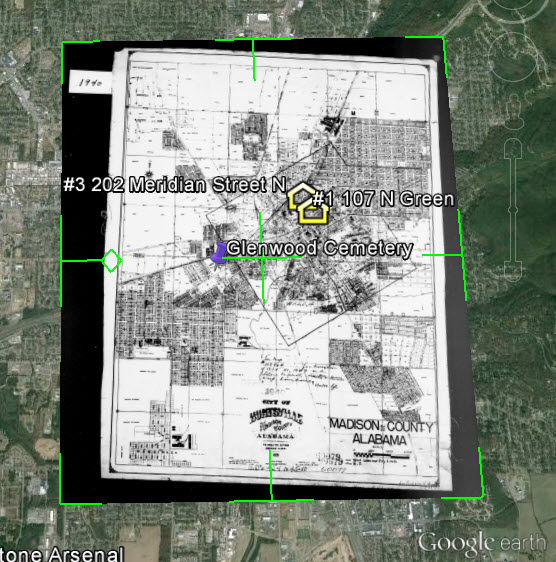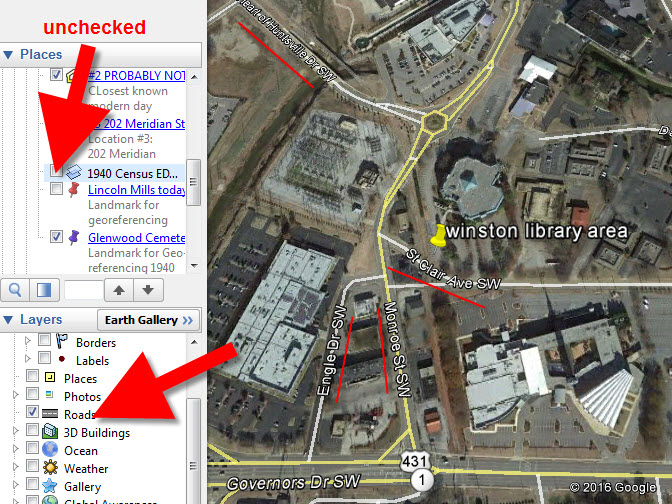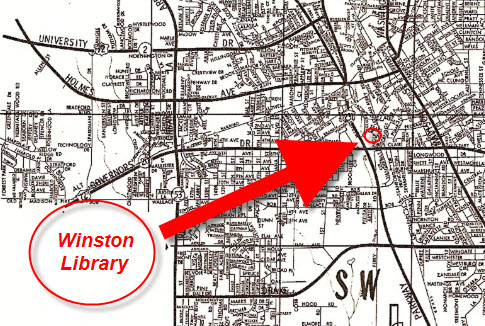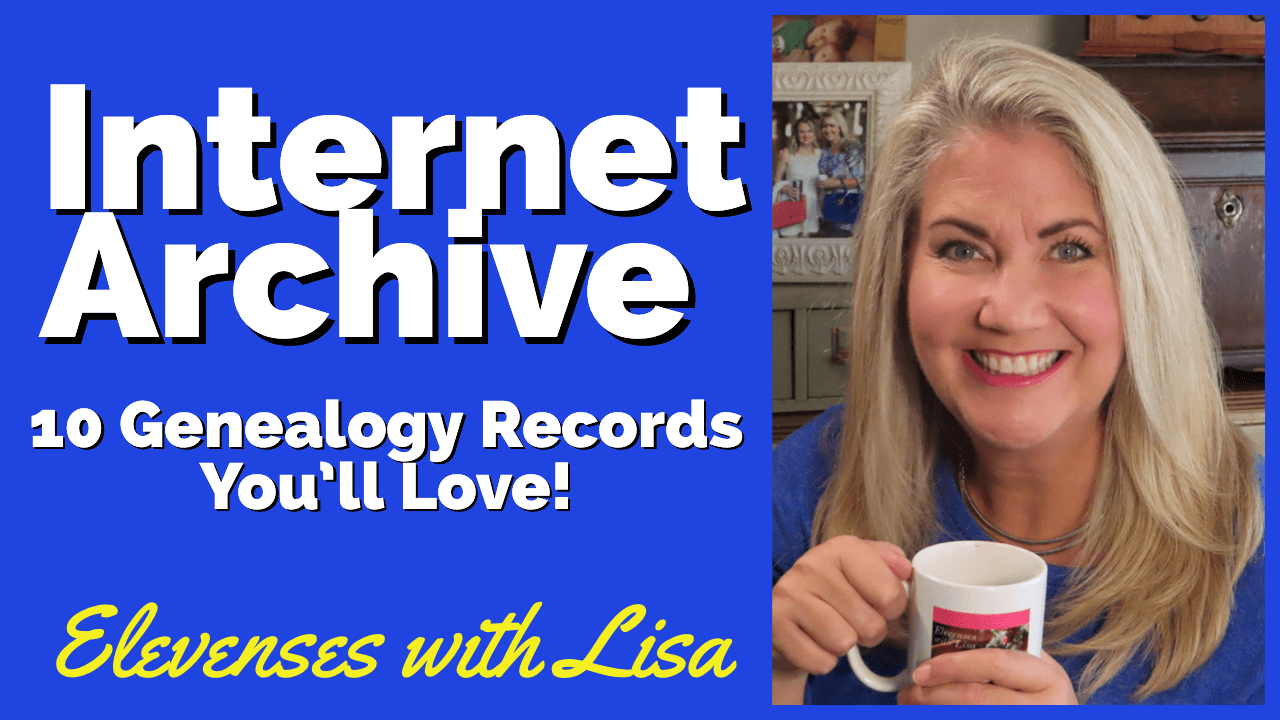4 Steps for Using Google Earth for Genealogy
Use Google Earth for genealogy to find long-lost family locations on modern maps. Here’s how!
It can be very surprising to discover that you lived somewhere that you never knew you lived. That was the case for Professional genealogist Alvie Davidson, who recently wrote to me. He’d done some fantastic sleuthing on his own recent family history, and discovered that his family had lived in Huntsville, Alabama when he was a toddler. “This is the first I have even known they lived in Madison County, AL.” But he was not sure about how to use Google Earth to help him locate the family addresses he’d discovered.
“I have learned from the U S Government that my parents lived at (three) different addresses in Huntsville, Madison County, AL when I was a toddler in 1944….I never knew we lived in Huntsville but I learned my mother worked for munitions productions during World War II at Redstone Arsenal. She worked several months toward the end of 1944 and had to quit due to onset of pregnancy. We moved to Florida shortly after she left employment at Redstone Arsenal because we show up on the 1945 Florida State Census.”
Alvie sent me three family addresses. Then he asked for some step-by-step help instructions on how to put Google Earth to work to identify their location today.
4 Steps to Revealing More with Google Earth
1. Search each address in Google Earth. Enter the address in the search box in the upper left corner of Google Earth. If you get a hit, mark it with a placemark (clicking the button that looks like a push pin in Google Earth’s toolbar) and name it. In this case I found two of the three street addresses.
2. Locate a map of the area for the appropriate time period. With a little Google searching, I found the 1940 census enumeration map for Huntsville at the National Archives website. Here’s what that map looks like. (Image right) I then went in search of each of the three addresses on the map.
In this case, I conducted a block-by-block search of the 1940 enumeration district map for the missing address: 110 Winston Street. Unfortunately, not all the street names were clearly legible on this particular map, and I was unable to locate it.
You can learn more about locating enumeration district maps in my article How to Find Enumeration District Maps.
Genealogy Gems Premium Members: log in and watch my Premium video 5 Ways to Enhance Your Genealogy Research with Old Maps featuring instruction for locating and using enumeration district maps.
3. Overlay and georeference the enumeration district map in Google Earth to compare the past to the present. Georeference just means to match up known landmarks on the historic map with physical locations on the modern-day map, thereby allowing you to match the two maps up together. By so doing, I was able to locate on the enumeration district map the modern-day locations of the two addresses that I found using Google Earth.
There are businesses in both locations today. Below right is a screen shot showing the current location of one of those addresses. Clearly no longer the old family home.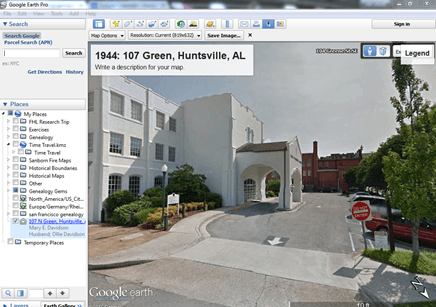
4. Dig deeper for addresses that have changed. As I mentioned previously, I searched for the 110 Winston Street address in Google Earth with no result. If that happens to you, remove the house number and run a second search on the street name alone. Numbers can change, but it is important to verify whether the street still exists today.
In this case, Google Earth did not locate a Winston Street in Huntsville, AL. Knowing that errors and typos can happen to the best of us, I ran a quick Google search for Huntsville, AL city directories, and verified that indeed Winston Street did exist at that time in history. So, at some point between 1940 and today, the name appears to have been changed.
I headed back to Google and ran the following search query:
“winston street” “huntsville alabama”
The quotation marks tell Google that each exact phrase must appear in all search results. The phrases will appear in bold in the snippet descriptions of each result.
The result above caught my eye because it mentions the “Winston Street Branch Library.” Even when street names change, buildings named for those streets often don’t. However, in this case, the website discusses the history of the library, and the Winston Street Elementary School. According to the website, the library “became a part of the Huntsville Public Library (now Huntsville-Madison County Public Library) in 1943. In 1947, the branch was renamed the Dulcina DeBerry Library.” Perhaps the street was renamed at that time as well.
Genealogy Gems Premium Members: Sign in and watch the Ultimate Google Search Strategies video class to learn more.
Jumping back into Google Earth I entered “Winston Street Branch Library” in the search box, and was immediately taken to the location, which is just south of the other two known addresses! At this point I would recommend to Alvie, who is a Genealogy Gems Premium Member, to watch my video class Best Websites for Finding Historical Maps to track down additional maps from the time frame that may have Winston Street clearly marked on the map.
Once I identified this landmark, I then marked the location with a placemark. You can turn off the 1940 enumeration district map overlay by unchecking the box next to it in the Places Panel. Doing this revealed the location on the modern day map. Finally, I headed to the Layers panel and clicked the box next to the “Roads” overlay to reveal the modern day street names.
You can use this technique when you have more success than I did in finding an old address on an old map. Overlay the map, position a placemark on the location, and then turn the overlay off. With one click of the Roads layer you can now see the current street name for the old location you found on the map overlay.
Further digging online did deliver additional maps from the era and area:
We all have locations in our family history that have given way over time to new buildings and parking lots. By using the power of Google Earth, Google search, and historic maps, they don’t have to be lost forever.
Get Started with Google Earth for Genealogy

Learn all these Google skills–with step-by-step tutorials and video demonstrations–in Lisa’s book and Google Earth video tutorial. Click here for a special price on the bundle!
FREE video: Get Started with Google Earth for Genealogy
Google Bundle! The Genealogist’s Google Toolbox Second Edition PLUS learn how to create your own historical map overlays in my Google Earth for Genealogy 2-video CD set.
Use Google Earth to Plot Your DNA Matches
Genealogy at the State Library of Pennsylvania
One thing that many genealogists have in common is a connection to Pennsylvania. Perhaps one of your family tree branches extends back to the early founding of the Pennsylvania colony. Or it may be that one of your ancestors was one of the hundreds of thousands who arrived through the port of Philadelphia. Even if you don’ t have Pennsylvania ancestors the State Library of Pennsylvania has a lot to offer.

Genealogy at the State library of Pennsylvania
In this episode I’ll be sharing with you a video of my interview with two librarians from the State Library of Pennsylvania. We’ll discuss their collections and specifically what’s available through their website. After the interview I’ll show you some specific search techniques that you can use at the State Library of Pennsylvania website, including a trick that you can use with any state library website.
Elevenses with Lisa Episode 46 Show Notes
My special Guests from the State Library of Pennsylvania:
Kathy Hale, Government Documents Librarian
Amy Woytovich, Genealogy Librarian
State Library of Pennsylvania Website
Genealogy at the State Library of Pennsylvania
State Library of Pennsylvania Update
This interview was recorded in December 2020. Here’s the latest update (as of this writing) on the library closure and access:
- The State Library is currently closed to all visitors. However, staff is teleworking. People may send inquiries to ra-reflib@pa.govand staff will answer questions as best they can.
- Renovations have begun on our library in the Forum Building. There may be times we cannot get to the materials requested because of the construction.
- Interlibrary loan services are available, but patrons must check if their home library has the equipment and are open for patrons to use that equipment. The Library still ships all over the U.S.
- Watch their website for instructions on how to access the State Library of Pennsylvania when it does reopen to the public.
The State Library of Pennsylvania Background
The library has been a federal repository library since 1858, and is one of the oldest in the country. The government printing office deposits materials here.
The State Library of Pennsylvania Collection
The State Library of Pennsylvania physical collection includes:
- 30,000 volumes
- 100,000 reels of microfilm
- A million pieces of microfiche
The State Library of Pennsylvania digitized items include:
- County and family histories
- Local histories
- Small church histories from rural areas
- City directories
- Passenger lists
- Regimental histories (Revolution to Spanish-American War)
- Pension Lists
- Pennsylvania Published Archives (collection of military, government, marriage, immigration records from colonial times)
- The 1940 U.S. Federal Census
Pennsylvania Documents
Example: a report for Pennsylvania of the 25th and 50th anniversaries of the Battle of Gettysburg. Includes information gathered at reunions including names, pictures, and more.
U.S. Government Documents – Serial Set
This collection includes reports to the legislature from agencies and institutions. Example: The Daughters of the American Revolution (DAR) were compelled to provide to Congress a yearly report of the names of people approved by DAR. These can be accessed through many libraries, the federal government or by contacting the State Library of Pennsylvania via email: Ra-reflib@pa.gov
State Library of Pennsylvania Research Guides
Amy discusses research guides available on the website. However, here is the link to the topics she specifically mentions such as Cemeteries and Zeamer collection – recorded information about Cumberland County PA cemeteries. General Research Guides page. These research guide pages include links to additional helpful websites.
State Library of Pennsylvania website’s Genealogy Page
At the top of the page look at the For General Public tab which will take you to all of the genealogy research guides. Visit the Genealogy page at the State Library of Pennsylvania.
Newspapers at the State Library of Pennsylvania
The library’s collection of newspapers includes papers from all 67 Pennsylvania counties on microfilm. They do have a lot of digitized newspapers at the Pennsylvania Photos and Documents Collection at the Power Library.
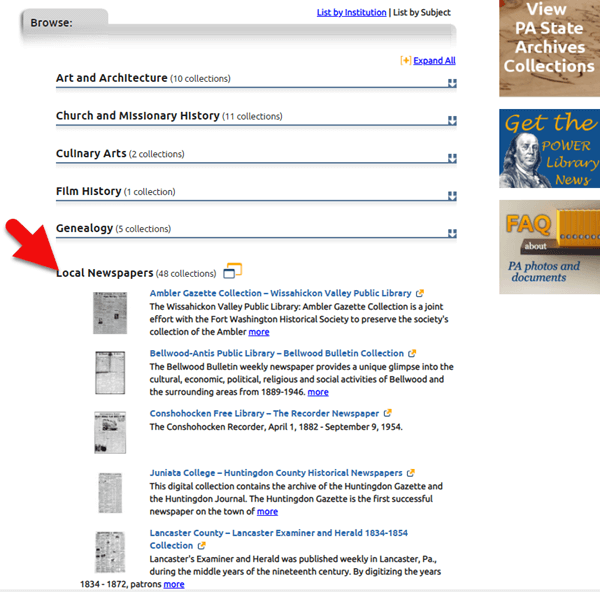
Newspapers at the Power Library
The Power Library
You can find the Power Library by going to the libraries home page, and under the For General Public tab go to Our Collections > Power Library. Or visit the Power Library website at Powerlibrary.org.
- Electronic Databases: you have to be a resident with a library card.
- Digital Documents: you don’t have to be a Pennsylvanian to access this collection.
At the top of the Power Library home page on the right you’ll find Digital Docs and Photos:
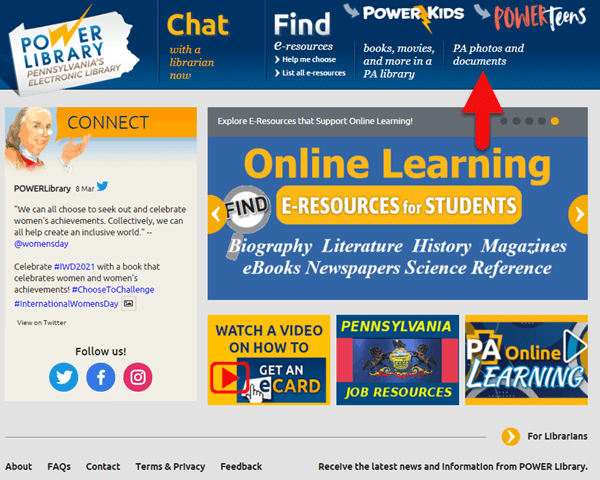
Pennsylvania Photos and Documents Collection at the Power Library.
There you will find many materials from Pennsylvania colleges including yearbooks. You can browse by subject area, with Genealogy being one of those areas.
Interlibrary Loan and Lookups
At the time of the interview the library was not open for interlibrary loan and lookups. Check the website for the latest updates.
The library does loan its newspaper microfilm. Up to 5 reels of microfilm per request. Kathy says that if you find a newspaper article at Newspapers.com and you see the title, date and the page that an article is on, you can provide the information to the interlibrary load reference librarian at your local library and place a request for a scan of the article from the State Library of PA microfilm. The article can then be returned to you digitally through interlibrary loan. The digitized scan is yours to keep.
The Librarians Favorite Collections
Amy’s Pick: Historic maps found at the library’s website Home > For General Public > Genealogy and Local History > Maps and Geographic Information. This includes Sanborn Fire Insurance Maps. Note: log in with a library card may be required. Contact the library with questions.
Kathy’s favorite collections include:
- Map Collection consisting of over 35,000 maps.
- The 5 generations from the Mayflower collection.
Usage of Materials
Usage rights and copyright are important considerations when utilizing library materials. Usage depends on the individual item’s copyright. It should be researched as much as possible. Check the meta data of digital images for copyright information.
How to Get Research Help from the State Library of Pennsylvania
“Think of Amy and I as your personal librarians.” Kathy Hale, Librarian
Contact State Library staff by phone at 717-787-2324 or by email at:
- Reference Questions: ra-reflib@pa.gov
- Law Reference: ra-law@pa.gov
- Interlibrary Loan: ra-ill@pa.gov
- Makerspace: ra-edmakerspace@pa.gov
Lisa’s Tips for Using the State Library of Pennsylvania Website
Maps for Genealogy
At the website go to Home page > General Public Tab > Our Collections > Search our Resources.
- Type in a location and the word map
- Use the filters on the right side of the page > Library > State Library
- Click to select a map
- Try filtering to Full Text Online
- Look for the Online Access link, just above Text Item Call Number.
On the map viewer page, click the thumbnail button (looks like a checkerboard) to see multiple pages at a time. You’ll find the Download button in the bottom right-hand corner. The Print button is in the upper right corner.
Cite your source: Go back to the result page, and scroll down. Click the red button called Cite This. This allows you to copy the source citation which you can then paste into other documents and programs.
Newspapers for Genealogy
The Library of Congress Chronicling America website has many Pennsylvania old newspapers, but it doesn’t include all of the newspaper that the library has in its collection. Here’s how to find old Pennsylvania newspapers at the State Library website:
- On the State Library website go to General Public > Research Guides > Newspapers
- Click the link to the Pennsylvania Newspaper Archive
- Browse by title or date, or use the drop-down menus
- On the viewer page, zoom into the desired article. Then click Clip/Print Image
- Right-click on the clipped image to save it to your hard drive.
- The Persistent link is the URL address to your clipping.
Google Site Search Tip
This tip comes from my book The Genealogist’s Google Toolbox and my Premium Membership video The Genealogist’s Google Search Methodology.

Available at the Genealogy Gems store.
Many websites have their own search engine. However, each search engine is only as good as it was programmed. If you can’t find what you want on a website like the State Library PA website, try using a Google site search. Site search tells Google to search for your search terms only on the website you specify.
In my example in the video, you can see that Google found the one page mentioning the surname in a listing of microfilms much faster than I would have found it digging around and navigating the website itself. This page was not a card catalog entry so it would not have come up in a search of the catalog on the website.
Learn More About the State Library of PA Collections
In episode 43 of Elevenses with Lisa we discussed genealogy records available for free at the Internet Archive. The State Library of Pennsylvania has been partnering with he Internet Archive to digitize many additional items from their collection. You can access these items for free at the State Library Internet Archive Collection. This collection includes a large number of World War I materials as well as a growing number of 19th and 20th century pamphlet volumes.
Resources
- Get My Free Genealogy Gems Newsletter – click here.
- Bonus Download exclusively for Premium Members: Download the show notes handout. (Not a Premium Member? Become a Genealogy Gems Premium Member today.)
Genealogy Gems Podcast Episode 235
Federal court records are wonderful because they are so packed with genealogical information. But knowing which records are available and where to find them can sound daunting, and that stops many genealogists from ever tapping into them. In this episode our aim is to fix all that. Professional forensic genealogist Michael Strauss is here to pull back the curtain and introduce you to these valuable records.
You know Michael from our Military Minutes segments here on Genealogy Gems. He also recently introduced us to descendancy research on Genealogy Gems Premium Podcast episode 174. The response to that episode was terrific. Many of you wrote in to say that it opened up a new avenue of research for you. This episode promises to do the same.
Podcast host: Lisa Louise Cooke
November 2019
Download the episode mp3
GEM: Federal Court Records with Michael Strauss
Where are Federal Records Found?
Federal Court Records are initially held in the custody of the national federal courthouses where the events occurred.
The National Archives and Records Administration (NARA) was founded in 1934.
National Archives, Washington DC (Archives1)
700 Pennsylvania Avenue, NW
Washington, DC 20408-0001
Toll-free: 1-866-272-6272
Email: archives1reference@nara.gov
Regional Archives – about a dozen across the country – hold record geographically by area. View the locations here at the National Archives website.
Are all the records catalogued on the National Archives website?
- Master federal indexes are not yet online. Indexes are found at the location/level where these record files were created.
- Each of the federal courts are found in record groups (RG).
- Get the finding aid for the record group online at the National Archives website. That will point in the right direction as to where to get the indices.
- Resource: Finding Aids at the National Archives
Types of Federal Courts:
The Federal Court System of the United States was established under the Judiciary Act of 1789 (1 Stat. 76) on September 24, 1789. Click here to read more about the role and structure of the federal courts at the United States Courts website.
District Courts:
Trial Courts of the United States. Their jurisdiction include:
- Admiralty
- Equity
- Bankruptcy
- and Naturalization
These courts began at different times dependent on the geographic area and when the states were created.
Circuit Courts:
Originally established in 1789 as three courts and later expanded to nine courts by 1866. Circuit Courts have jurisdiction over all matters (especially criminal) covered by Federal Law. Abolished in 1911 and taken over by District Courts.
Circuit Courts of Appeals:
Established under the Federal Court System by an Act of Congress on March 3, 1891 (26 Stat. 826), by acquiring the appellate jurisdiction of the U.S. Circuit Courts and later the U.S. District Courts. They have different geographic jurisdictions than the regular federal courts.
Supreme Court:
It is recognized as the highest court in the United States operating as an appeals court. Although a criminal case may have first been heard at the local level, it may have escalated to a federal court. Therefore, there could be federal records on that case.
Application for the Genealogist:
Michael has found that some of the richest records in the federal court system have come from the criminal court records. Our ancestors did get into trouble upon occasion. Michael’s grandfather was arrested in the 1940s and he was able to obtain those records.
Searching for Federal Records
Is it worthwhile to head to the National Archives and generally search to see if an ancestor has records? Or is it best to identify a case first, perhaps through a newspaper article, and then go to the National Archives location that would have the records for those identified cases?
No one is wasting their time going and searching the records. It’s a great way to get familiar with them. However, identifying a case through other records first can lead you quickly to the federal records. (Michael first found his grandfather’s case in a newspaper article.)
Types of Federal Court Records:
Dockets: Lists of cases heard by the court. Sometime referred to as court calendars.
Minutes:
Brief daily accounts of all actions taken by the court.
Orders:
The specific judgments or orders of the court. An example would be an order granting citizenship.
Briefs:
Legal document arguing why one Party should prevail on a case.
Mandates:
When a Defendant obligates themselves to engage in activities in exchange for suspension of sentence. Frequently seen in Criminal Court.
Case Files:
All the loose documents relating to the case bundled together.
How to Find Records at the Archives:
- Review the finding aid
- Request the Index and find the name and corresponding file information
- Request the record
An appointment is not required. They will pull the records as you request them. Record groups are pulled at different times. For the most part you will have the opportunity to view the original documents.
Record Groups:
The National Archives is set up by record groups, such as:
Records of the U.S. District Court – RG 21
Records of the U.S. Supreme Court – RG 267
Records of the U.S. Court of Appeals – RG 276
Records of the U.S. Court of Claims – RG 123 (Claims against the US. Individual citizens could actually file claims against the US)
Request the individual record groups separately.
Bankruptcy:
Bankruptcy Acts were passed by Congress usually after business disturbances or financial recessions.
Bankruptcy Act of 1800
This act followed the business disturbances of 1797.
The first national bankruptcy act was approved on April 4, 1800 (2 Stat, 19.) It provided for an effective period beginning June 2, 1800 and continuing for 5 years.
It applied only to merchants or other related parties. The act provided for compulsory or involuntary bankruptcy, but not for voluntary bankruptcy. Because of its limited applicability the act was repealed on December 19, 1803, just months before its expiration date.
Bankruptcy Act of 1841
This act followed the business panic of 1837.
The second national bankruptcy act was passed on August 19, 1841 and was to take effect on February 1, 1842.
The law allowed voluntary bankruptcy to all debtors, but limited involuntary bankruptcy to merchants, bankers, factors (an agent or commissioned merchant), brokers, and traders.
It eliminated the requirement of the consent of the creditor for a discharge. The bankrupt filer, however, could obtain his discharge through a jury trial if the jury found that he had surrendered all his property and had fully complied with the orders of the court.
Bankruptcy Act of 1867
This act followed the post-Civil War recession of 1866-1867.
On March 2, 1867, Congress approved the Nation’s third bankruptcy act to assist the judges in the administration of the law, the act provided for the appointment by the court of registers in bankruptcy.
The registers were authorized to make adjudications of bankruptcy, to hold and preside at meetings of creditors, to take proofs of debts, to make computations of dividends, and otherwise to dispatch the administrative business of the court in bankruptcy matters when there was no opposing interest.
In cases where opposition to an adjudication or a discharge arose, the controversy was to be submitted to the court.
Bankruptcy Act of 1898
This act followed the business panic of 1893 and the depression that followed. We are currently under the umbrella of this fourth act.
In 1889 The National Convention of Representatives of Commercial Bodies was formed to lobby for bankruptcy legislation. The president of the Convention, Jay L. Torrey, drafted a new Bankruptcy Bill otherwise known as the “Torrey Bill.”
In 1898 Congress passed a bankruptcy bill based on the previous Torrey bill. This Act also called the “Nelson Act” was passed July 1, 1898, (Ch. 541, 30 Stat. 544.) It was the first United States Act of Congress involving Bankruptcy that gave companies an option of being protected from creditors. Previous attempts at bankruptcy law had lasted at most a few years. Its popular name is a homage to the role of Senator Knute Nelson of Minnesota.
Bankruptcy files are in the custody of the National Archives and now stored offsite at the National Archives branch in Kansas City, MO. Researchers should contact the Archives directly to conduct searches. Some indexes are still maintained at the regional archives.
Bankruptcy Records Examples
1) Two pages from the Bankruptcy File of Percival L. Strauss of Bethel Twp. Berks Co. PA. 1 Page is the petition and the second page is a page from “Schedule A” which lists the debt owed by the bankrupt.
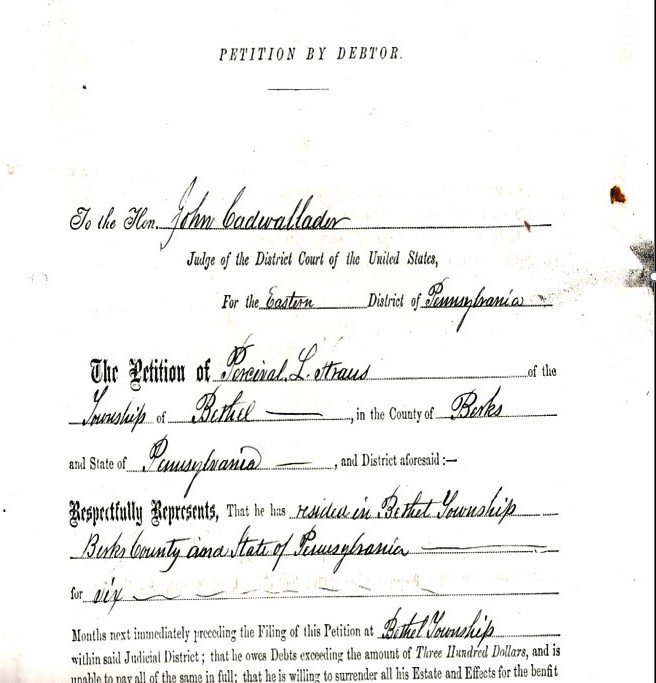
Petition by Debtor: Percival L. Strauss
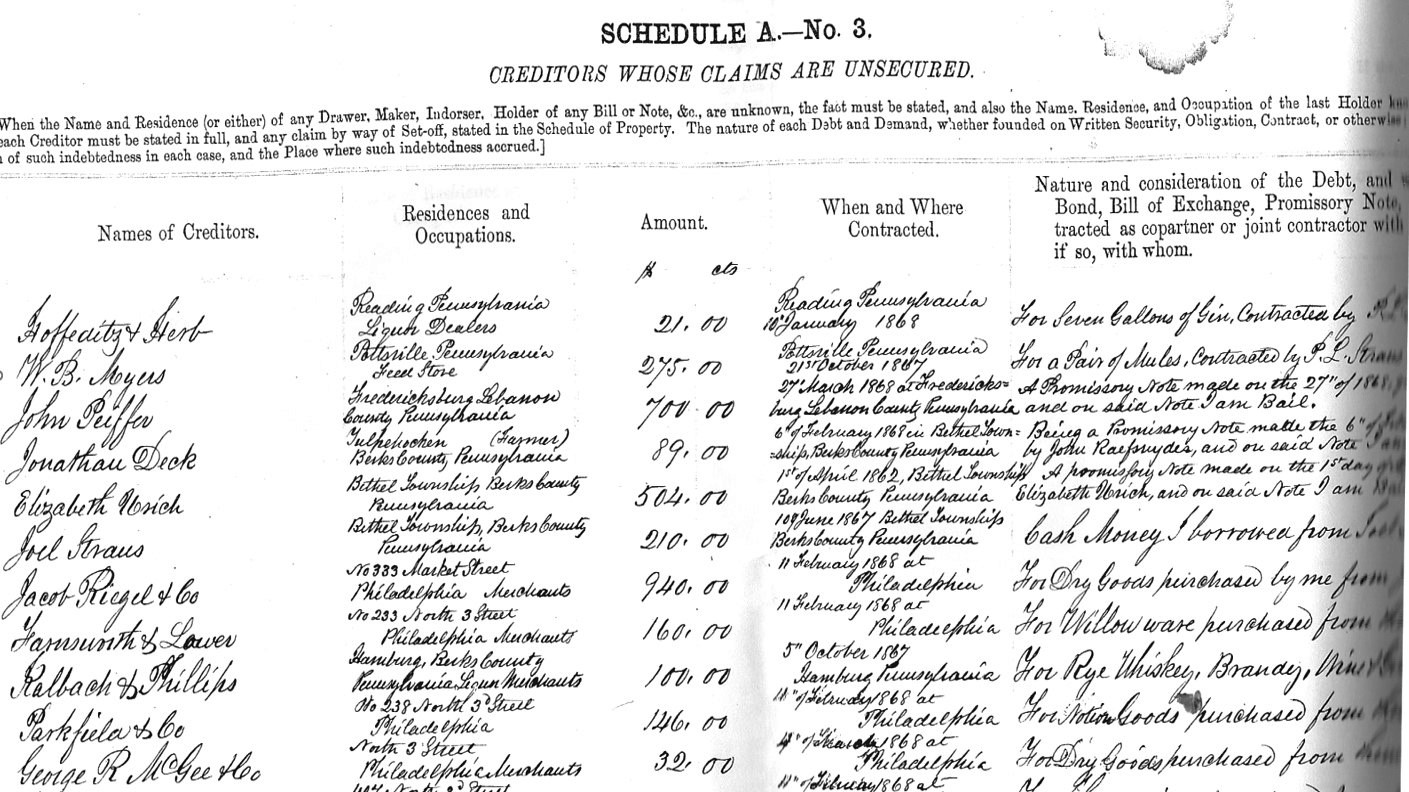
Schedule A – No. 3: Creditors Whose Claims are Unsecured (Percival L. Strauss)
2) Tintype of Percival L. Strauss-circa 1872 within a few years of filing Bankruptcy.

Percival L. Strauss. (Courtesy of Michael’s cousin Harry B. Strauss of Myerstown, PA)
Biographical information:
Percival Long Strauss (Son of Benjamin Strauss & Rebecca Long)
Born: December 16, 1830-Upper Bern Township, Berks Co. PA
Died: Mohnton, Berks Co. PA
Married: April 9, 1855-Bethel Township, Berks Co. PA to Malinda Smith (12 Children)
May 18, 1867 (Page 3, Column 6), in the Berks & Schuylkill Journal newspaper the entry reads: “P.L. Strauss of Bethel Twp. Berks County, PA Class #13 License paid $10.00 to conduct store (merchant).”
This is the business he had at the time of his bankruptcy filing on May 27, 1867 in Philadelphia, PA in the Eastern District of Pennsylvania.
Types of Information Found in Bankruptcy Records:
- Lists of creditors (name, address)
- Amount of money owed (the debt)
- Specific information about the items for which the debt was incurred
- Total dollar amounts
Follow the Federal Record Trail:
Information found could lead you to additional records. For example, if your ancestor filed for bankruptcy due to debts associated with his business, you could go back to the local level to look for records such as a business license, newspaper articles, etc.
Lisa suggests searching Google Books for digitized items such as county histories, almanacs, catalogs, merchant association books, etc. Here’s an example of a bankruptcy notice found in Google Books (which is free) for Michael’s ancestor Percival L. Strauss
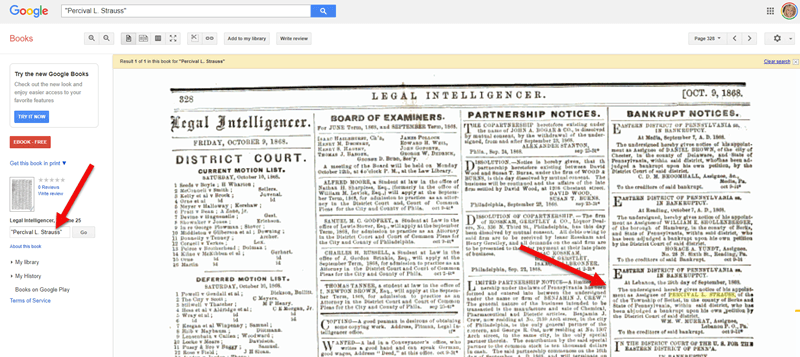
Searching for Percival L. Strauss bankruptcy notice in Google Books
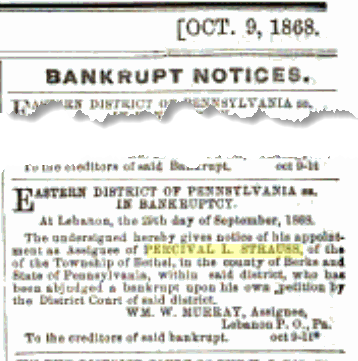
Bankruptcy notice (Oct. 9, 1868) found in Google Books
The National Archives has been consolidating all of the bankruptcy records. It is going to be the Kansas City, MO branch of the National Archives, which currently has the Patent files.
Examples of bankruptcy cases:
- Bankruptcy Act of 1841 – Edgar Allen Poe filed bankruptcy in 1841.
- Bankruptcy Act of 1898 Act – Dean Martin in New York
Amendments to the most recent bankruptcy act include:
1933: The “1898 Bankruptcy Act”
Amended to include railroad reorganization, corporate reorganization, and individual debtor arrangements.
1938: The “Chandler Act”
Amended the earlier 1898 Bankruptcy Act, creating a menu of options for both business and non-business debtors. Named for Walter Chandler.
1978: The 1898 Bankruptcy Act
Replaced by The Bankruptcy Reform Act. This Act is still used today.
Writs of Habeas Corpus:
Habeas corpus is a court order from a judge instructing a person who is detaining another to bring the detainee before the court for a specific purpose.
It was often used during the Civil War for soldiers under the age of 18 years and in reference to runaway slaves.
Writs can be found in most case files. They usually involves a petition, transcript, order, and the writ when ordered by the Judge. Contact the National Archives regarding RG19 for records pertaining to this set of documents and indexes.
Fugitive Slave Act:
The Fugitive Slave Act of 1850 was passed by the United States Congress on September 18, 1850 as part of the Compromise of 1850. It was one of the controversial acts passed down by law. Runaway slaves could be returned with the help of the Federal Government.
Records can include:
- Petitions
- Affidavits
- Testimonies
- Documentation of ownership
Records are typically found in the court of original petition and the court with jurisdiction over the area where the slave escaped. Search under the slave holder’s name.
The Confiscation Act of 1862:
Passed by an act of Congress on July 17, 1862, the full title is “An Act to Suppress Insurrection, to Punish Treason and Rebellion, to Seize and Confiscate the Property of Rebels, and for Other Purposes.”
This Act gave the power to take the land and businesses of persons who served the Confederacy. Records include case files include; petitions, orders of the court, proofs of public notice, and notices of seizure
Example: General Robert E. Lee. The act covered land under Union Control. Lee lived in Northern Virginia, and his home was confiscated. The file has a complete inventory of his house. The location is now the Arlington National Cemetery.
Federal Criminal Records
Criminal records could include cases covering:
- Treason
- Assault and Battery on the high seas
- Conspiracy to over through our government
- Smuggling
- Forgery
- Counterfeiting
- Carrying on a business without a license
- Not paying taxes
Naturalization Records:
Records were created:
- at the federal level
- at the local level – local court at the county level
1790: The first national act created a two-step process:
- Declare your intention to become a citizen
- File your petition for citizenship
Your ancestors may not have finished the process, and they may have filed both at local and federal levels.
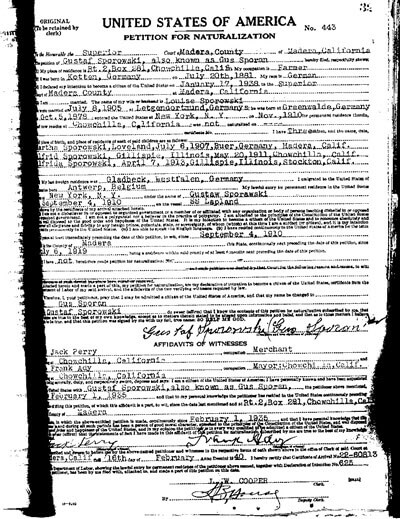
Petition for Naturaliztion
Resource: The Family History: Genealogy Made Easy Podcast
Episodes focusing on the Naturalization process include:
Episode 29: Immigration and Naturalization Records for Family History, Part 1
This episode begins a 3-part series on U.S. immigration and naturalization records. Learn about passenger arrival lists in the U.S., little-known certificates of arrival and naturalization records: how to find them and what’s in them.
Episode 30: Immigration and Naturalization Records for Family History, Part 2
In this episode we focus on passenger departure records created in European ports. He also talks more in-depth about U.S. naturalization records.
Episode 31: Immigration and Naturalization Records for Family History, Part 3
In-depth discussion of passenger list annotations and the immigrant’s experience at Ellis Island. Unlock the meaning of those mysterious scribbles on 20th-century passenger manifests!
Learn More with Michael Strauss:
Visit Michael’s Website: Genealogy Research Network
Register for Michael Strauss’ week-long Salt Lake Institute of Genealogy (SLIG) 2020 course called Court #2 A Guide to Treasures Found in Federal Records.
Hear More from Michael Strauss: Genealogy Gems Premium Membership
Gain access to the complete Premium podcast archive of over 150 episodes and more than 50 video webinars, including Lisa Louise Cooke’s newest video The Big Picture in Little Details.
More Reading:
Black, Henry Campbell. Black’s Law Dictionary. Sixth Edition. St. Paul: West Publishing, 1990.
Burton, William C. Burton’s Legal Thesaurus. New York: Macmillan Library Reference, 1998.
Chapin, Bradley. Criminal Justice in Colonial America, 1606–1660. Athens: University of Georgia Press, 1983
Eichholz, Alice ed., Red Book: American State, County, and Town Sources, 3rd Ed Provo: Ancestry, 2004.
Evans, Barbara Jean. The New A to Zax: A Comprehensive Genealogical Dictionary for Genealogists and Historians. Second Edition. Champaign: B.J. Evans, 1990
Neagles, James C. and Lila Lee Neagles. Locating Your Immigrant Ancestor: A Guide to Naturalization Records. Logan: Everton Publishers, 1986.
Rapaport, Diane. New England Court Records: A Research Guide for Genealogists and Historians. Burlington: Quill Pen Press, 2006
Rose, Christine. Courthouse Research for Family Historians. San Jose: CR Publications, 2004.
Schaefer, Christina. Guide to Naturalization Records of the United States. Baltimore: Genealogical Publishing Company, 1997.
Szucs, Loretto Dennis, and Sandra Luebking. The Archives: A Guide to the National Archives Field Branches. Salt Lake City: Ancestry Publishing, 1988.
Thank you to Michael Strauss for contributing to these notes and sharing his expertise!
This free podcast is sponsored by:
MyHeritage.com is the place to make connections with relatives overseas, particularly with those who may still live in your ancestral homeland. Visit www.MyHeritage.com
Learn German Handwriting
Katherine Schober of SK Translations, professional German script expert, translator, and author has created Reading the Old German Handwriting Online Course – so you can be reading those old German letters in just a matter of months. Complete with videos, flash cards, games, and more, this do-it-yourself course has students raving. Learn more here.
Read our latest articles at Genealogy Gems:
Dakota (AKA Kota Bear) makes Her Debut on this Episode

Please Help Us by Taking the 1 Minute Genealogy Gems Survey
Please help us create the best podcast for you by taking this very short survey.
Join Lisa Louise Cooke in person at Genealogy Roots
This event is now over.
Watch the video recap of Day 1 of Genealogy Roots in Salt Lake City:
Watch the video recap of Day 2 of Genealogy Roots in Salt Lake City:
Get the Genealogy Gems Podcast App Here
Follow Lisa and Genealogy Gems on Social Media:
- Instagram.com/genealogygemspodcast
- Facebook.com/genealogygems
- Pinterest.com/lisalouisecooke
- YouTube.com/GenealogyGems
Sign Up for the Free Genealogy Gems Newsletter
The Genealogy Gems email newsletter is the best way to stay informed about what’s available with your Premium eLearning Membership. Click below to sign up today.
Lisa Recommends Computer Backup with:
Learn more about Backblaze computer cloud backup and get your computer backed up today at www.backblaze.com/Lisa
Download the Show Notes PDF in the Genealogy Gems Podcast app.

